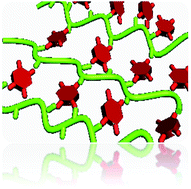In this communication, Yuan and co-workers prepared mesoporous polyelectrolyte networks through the ionic complexation between imidazolium-based cationic PILs and organic oligoacids in ammonia-containing diethyl ether. The as-synthesized porous networks exhibited good structural stability and large specific surface area up to 290 m2 g-1. This unique template-free strategy is very simple in operation and was shown to be generally valid for a variety of multivalent carboxylic acids, including many natural acid molecules. Interestingly, the performance of porous networks in dye removal from ethanol was demonstrated to be superior to activated carbon and mesoporous silica.
Organic acids can crosslink poly(ionic liquid)s into mesoporous polyelectrolyte complexes by Qiang Zhao, Sebastian Soll, Markus Antonietti and Jiayin Yuan, Polym. Chem., 2013, 4, 2432-2435.
Julien Nicolas is a guest web-writer for Polymer Chemistry. He currently works at Univ. Paris-Sud (FR) as a CNRS researcher.











